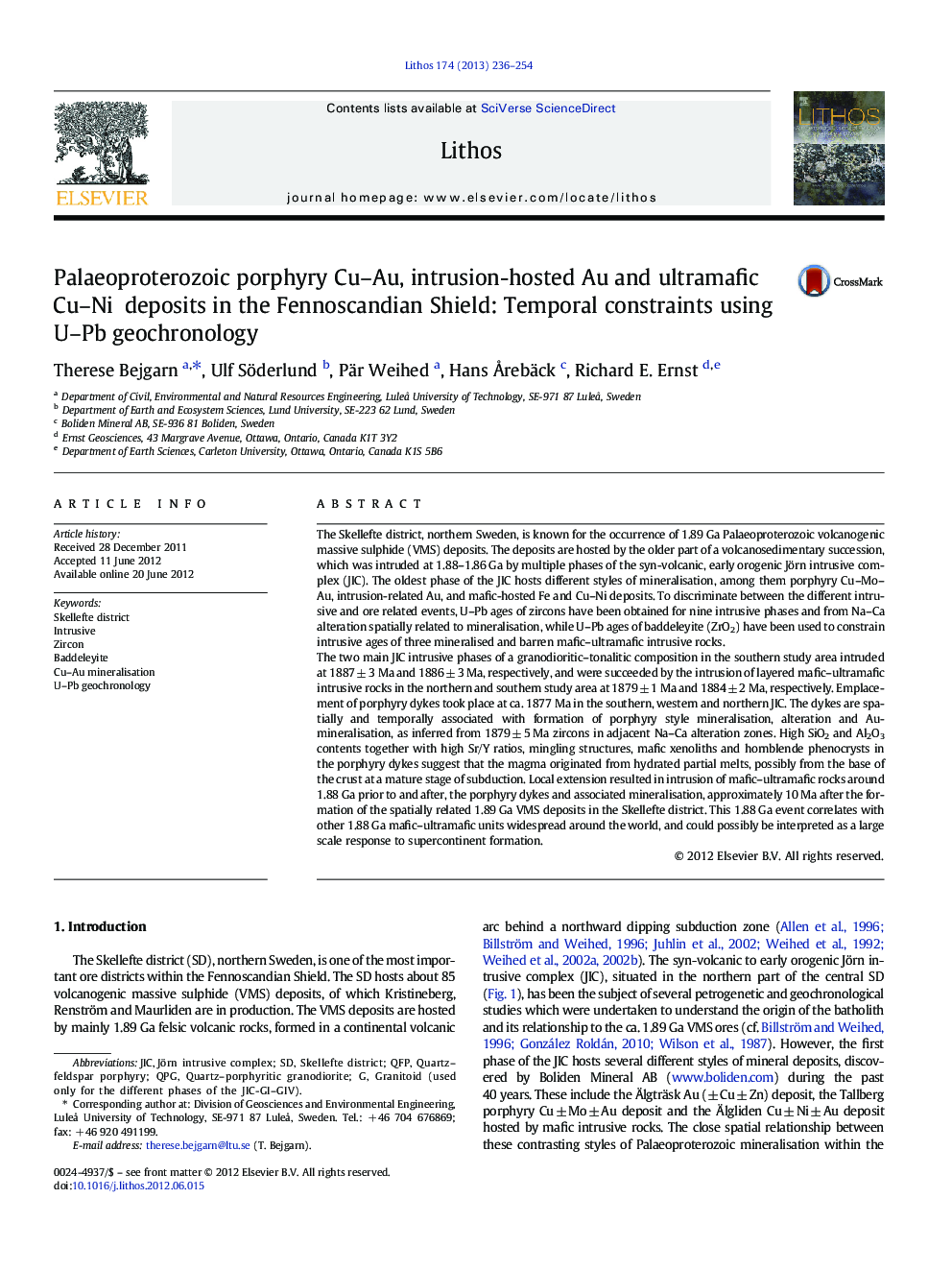| کد مقاله | کد نشریه | سال انتشار | مقاله انگلیسی | نسخه تمام متن |
|---|---|---|---|---|
| 4716190 | 1638690 | 2013 | 19 صفحه PDF | دانلود رایگان |

The Skellefte district, northern Sweden, is known for the occurrence of 1.89 Ga Palaeoproterozoic volcanogenic massive sulphide (VMS) deposits. The deposits are hosted by the older part of a volcanosedimentary succession, which was intruded at 1.88–1.86 Ga by multiple phases of the syn-volcanic, early orogenic Jörn intrusive complex (JIC). The oldest phase of the JIC hosts different styles of mineralisation, among them porphyry Cu–Mo–Au, intrusion-related Au, and mafic-hosted Fe and Cu–Ni deposits. To discriminate between the different intrusive and ore related events, U–Pb ages of zircons have been obtained for nine intrusive phases and from Na–Ca alteration spatially related to mineralisation, while U–Pb ages of baddeleyite (ZrO2) have been used to constrain intrusive ages of three mineralised and barren mafic–ultramafic intrusive rocks.The two main JIC intrusive phases of a granodioritic–tonalitic composition in the southern study area intruded at 1887 ± 3 Ma and 1886 ± 3 Ma, respectively, and were succeeded by the intrusion of layered mafic–ultramafic intrusive rocks in the northern and southern study area at 1879 ± 1 Ma and 1884 ± 2 Ma, respectively. Emplacement of porphyry dykes took place at ca. 1877 Ma in the southern, western and northern JIC. The dykes are spatially and temporally associated with formation of porphyry style mineralisation, alteration and Au-mineralisation, as inferred from 1879 ± 5 Ma zircons in adjacent Na–Ca alteration zones. High SiO2 and Al2O3 contents together with high Sr/Y ratios, mingling structures, mafic xenoliths and hornblende phenocrysts in the porphyry dykes suggest that the magma originated from hydrated partial melts, possibly from the base of the crust at a mature stage of subduction. Local extension resulted in intrusion of mafic–ultramafic rocks around 1.88 Ga prior to and after, the porphyry dykes and associated mineralisation, approximately 10 Ma after the formation of the spatially related 1.89 Ga VMS deposits in the Skellefte district. This 1.88 Ga event correlates with other 1.88 Ga mafic–ultramafic units widespread around the world, and could possibly be interpreted as a large scale response to supercontinent formation.
Relationship between the 1.89 Ga VMS deposits and formation of the 1.88 Ga porpyry deposits in the Skellefte district, northern Sweden.Figure optionsDownload as PowerPoint slideHighlights
► VMS deposits predate porphyry deposits by ~ 10 Ma in the Skellefte district, Sweden.
► Emplacement of porphyry dykes and associated mineralisation at ~ 1877 Ma.
► Layered mafic intrusions emplaced at 1884 ± 2 Ma and 1879 ± 1 Ma.
► Cu–Ni deposit occurs with mafic–ultramafic 1876 ± 1 Ma intrusion.
Journal: Lithos - Volume 174, 1 August 2013, Pages 236–254